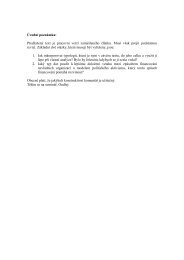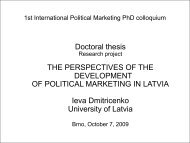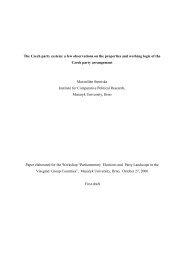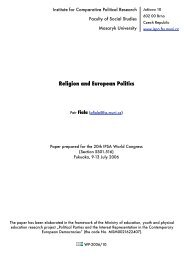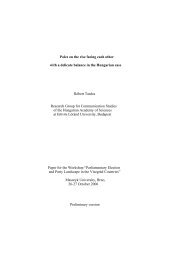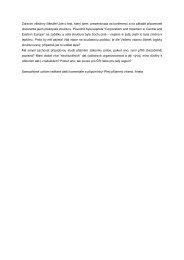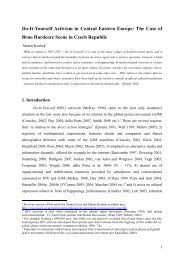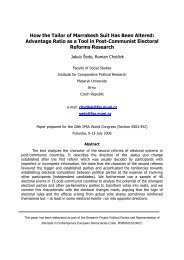CONTEXTUAL DETERMINANTS OF POLITICAL PARTICIPATION
CONTEXTUAL DETERMINANTS OF POLITICAL PARTICIPATION
CONTEXTUAL DETERMINANTS OF POLITICAL PARTICIPATION
You also want an ePaper? Increase the reach of your titles
YUMPU automatically turns print PDFs into web optimized ePapers that Google loves.
to be clearly specified. In case of completely closed regimes such as the non-democraticSoviet Union the opening of POS leads undoubtedly to a higher level of protest participation,since no other ways of influence are available to citizens at the time of political opening (seeespecially Tarrow 1998). In contrast, in case of well-established democracies this paperfocuses on, the open political opportunity structure decreases the amount of protest, sinceopportunities are open enough for people to influence politics through low-cost conventional,i.e. non-protest, means rather than by high-cost protest. 1Secondly, Meyer (2004) points out that the majority of social movements‟ studiesconcentrate on the start of political mobilization or on social movements completely excludedfrom the polity. Accordingly, they hypothesize the open political opportunity structure leadsto protest on the part of outsiders, since it is the only repertoire the excluded actors can optfor. Usually, these authors do not see that conventional action forms might be available too orbecome available later on under the conditions of open opportunities. In this case, there is noreason for citizens to rely on costly protest if they can employ low-cost conventional action.The other challenge is designs and measurements usually used for studying politicalopportunity structure. The vast majority of research that uses the POS framework is casestudies that explain the development of one social movement/contentious mobilization in onecountry (Costain 1992, Tarrow 1989, McAdam 1982, Meyer and Minkoff 2004). Thislongitudinal design sees aspects that change over time in one polity, or one policy-issue area,as political opportunity determinants, while keeping the general structure constant. A fewother available studies are concerned with cross-country comparison of social movements orcontentious politics (Kitschelt 1986, Kriesi et al. 1995). They compare overall opportunitystructures across national polities. However, there are very little quantitative studies and nostandard measurement of POS exist.This paper focuses on both types of contextual influence: the longitudinal and crosscaseexplanations. Drawing on social movement literature it considers political actors‟configuration to be responsible for longitudinal variation in political participation and seesnational context design as an account of differences among countries.1 Types of action such as signing a petition belong to low-cost forms; on the contrary, collective protest typessuch as demonstration and violent direct action are the most costly ones (Barnes and Kaase 1979).6



